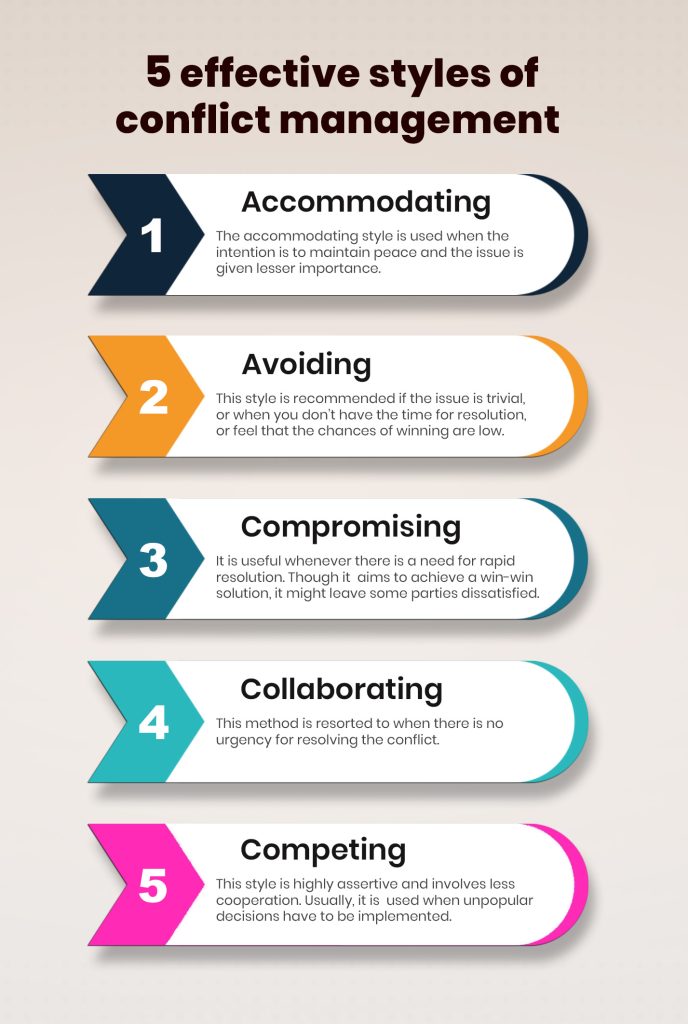
Conflict is always there. But do we really need to fight? Learn conflict management strategies to promote change and innovation and to create harmonious workplaces.
One of the biggest management lessons is that conflicts are a part and parcel of a team. One cannot avoid it and for a smooth business operation, it is highly crucial that conflicts be managed wisely.
Let’s keep in mind that today’s workplace is a mixture of people from entirely different cultures, academic backgrounds, and skill sets. Differing views are just a normal part of such a situation.
The subject of conflict is as complex as human psychology. How do you resolve the issues that crop up frequently without offending the involved parties and at the same time ensure that the solution is a productive one?
I believe that learning to accept conflict is perhaps your first step toward becoming a great leader. A team inevitably brings diverse ideas and the greatest challenge before the manager is to handle the diverse personalities and viewpoints smoothly.
There could be several reasons for workplace conflicts. A team consists of a diverse set of individuals. Personality differences cannot be avoided in such situations. Besides, poor communication or out-of-context remarks are common in a large group. Differences might also crop up over the work methods or perspectives. Lack of clarity on the job roles or competing job duties is another potential source of workplace conflict.
Definition of conflict management
Conflict management is the technique of identifying and managing conflicts sensibly and efficiently. Since conflicts are a natural part of the workplace, it is essential to understand and resolve conflicts in the right way. The concept of conflict management primarily revolves around the techniques for managing discord.
Conflict management strategies in organizational behaviour
Everything has two sides. The same goes for conflicts. There are both positive and negative conflicts and if managed well conflicts are positive for your organization.
Conflicts create a free flow of ideas, something that is highly essential for improved performance and effective decision-making. A group works at its best and gives the best results when ideas flow freely.

Only when there is the freedom to disagree do people share their conflicting thoughts that can spark creativity and promote out-of-box thinking. Repression of emotions in the team can build up frustration and anger.
Independent thinking should always be encouraged in a team and conflict is the inevitable result. When the team members have a voice they develop confidence and trust in the organization.
A great team shouldn’t focus on stifling conflicts. Instead, it should devise ways to manage conflicts and channel them to create a work environment that motivates the team to excel. Too much conflict can affect team performance, while too little conflict is a sure sign of dominating leadership and a team with zero room for creativity. The need is to ensure a healthy level of conflict and to manage it effectively.
How to manage conflicts effectively
Conflict management strategies in the workplace involve recognizing disputes and dealing with them to limit the negative aspects while simultaneously promoting the positive aspects of workplace conflict. It accepts that all conflicts cannot be resolved and rather managing them skillfully should be made the priority. The goal of conflict management is to drive the disagreement between the conflicting parties towards a mutually agreed favourable outcome.
One cannot suggest a particular conflict resolution style that can be generalized across all conflict situations. Each situation demands a different approach. According to the nature of the issue and the parties involved, you might need to select a style appropriate to ensure a peaceful resolution.
Types of conflict management
Here are the 5 effective styles of conflict management that you should familiarize yourself with.
Accommodating
The accommodating style is used when the intention is to maintain peace and the issue is given lesser importance. Here the accommodator gives in to the other party and accepts his suggestion. Even though this style leads to a peaceful atmosphere, too often results in built-up frustrations and resentment. The style is less assertive and provides a quick short-term solution. However, the unresolved issues might resurface in the long run.

Avoiding
Here the style is to withdraw from the conflict. By following this approach you would be postponing the issue whenever it surfaces or pretending to be unaware of the issue. This style is recommended if the issue is trivial, or when you don’t have the time for resolution, or feel that the chances of winning are low.
Compromising
A compromising style looks for common ground. The larger points are negotiated and the smaller ones are neglected. This style comes into the picture when the parties involved have equal power and are willing to work together toward a resolution. It is useful whenever there is a need for rapid resolution. Though it aims to achieve a win-win solution, it might leave some parties dissatisfied.
Collaborating
The collaborative style is an important model of conflict management and needs a high level of cooperation. It attempts to reach a win-win situation where everyone is satisfied. This method is resorted to when there is no urgency for resolving the conflict. There might be situations where you need to address multiple perspectives and the relationships between the parties is important. Here collaboration involves listening to multiple viewpoints, discussing the possibilities of reaching an agreement, and ensuring a mutual understanding among the parties.
Competing
The competing style takes a firm stand on the issue. The viewpoint of the opposite party is refused outright or a single viewpoint is pushed forward aggressively. This style is highly assertive and involves less cooperation. Usually, it is used when unpopular decisions have to be implemented. The powerful one will dominate and it results in a win-lose outcome. At times when you need to reach a quick agreement where the parties involved might need to be forced to accept, this style can be used. However, it is certain to bring trouble and increase the conflict in the long run.
Final thoughts
There is no tailor-made conflict resolution style to fit all situations. You need to match the process of conflict management to the situation in front of you. And of course, a lot will depend on personal preferences too. Choosing the right style of conflict management strategies to ensure a productive environment is an art as well as a science. End of the day it is on the manager’s shoulders to confront conflict situations, choose the appropriate resolution style, and promote peace, harmony, and a productive work environment.
FAQ
What are the 5 C’s of conflict management?
The 5 C’s of conflict management are competence, conflict, communication, conscience, and confidence.
What is the best way to handle conflict in the workplace?
Communicating, listening, and further developing a plan to resolve conflicts are the ideal methods.
How do you manage conflict in a team?
For managing conflict in a team, it is essential to listen carefully to each team member and negotiate resolutions based on that.
What are conflict management skills?
Communication, stress management, emotional intelligence, and problem-solving are essential to conflict management skills.
What are the 7 steps in conflict resolution?
The 7 important steps in conflict resolution are to create the right atmosphere, bring clarity in perceptions, focus on shared and individual needs, resolve the past, build shared power, generate options, and make mutual agreements for resolution.



